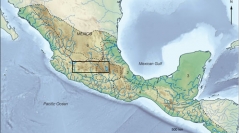

 Anthropozoologica
51 (2) - Pages 127-147
Anthropozoologica
51 (2) - Pages 127-147Zooarchaeology of Northern Mesoamerica has often been restricted to major archaeological sites and few regional syntheses are documented. Based on the original analysis of animal bone remains from ten archaeological assemblages and their confrontation with iconographic, historic and ethnographic data, this paper aims to propose a synthesis on the use of animals in central Mexico, from the Classic period to the Spanish Conquest. We selected sites from a similar environment but two cultural regions: Central Mexico and Western Mexico. The methodology used to compare the results from each assemblage is adapted to a particularly heterogeneous corpus and small-sized samples. The identification of 35 different taxa shows the use of a restricted and rather homogeneous spectrum. However variations are observed considering their proportions in each site. Only two domestic animals are recognised, the dog (Canis familiaris Linnaeus, 1758) and the turkey (Meleagris gallopavo Linnaeus, 1758), but none of the studied societies specialised in the breeding of these species. We then address the cases of hunting or garden-hunting and the exploitation of aquatic animals. Finally, hypotheses are presented about how the animals were used by the populations of Nothern Mesoamerica. Although a larger number of sites need to be studied to enhance the impact of our interpretations, this paper establishes a first attempt at regional synthesis on central Mexico.
Zooarchaeology, subsistence economies, Mesoamerica, hunting, herding, Trans-Mexican Volcanic Belt